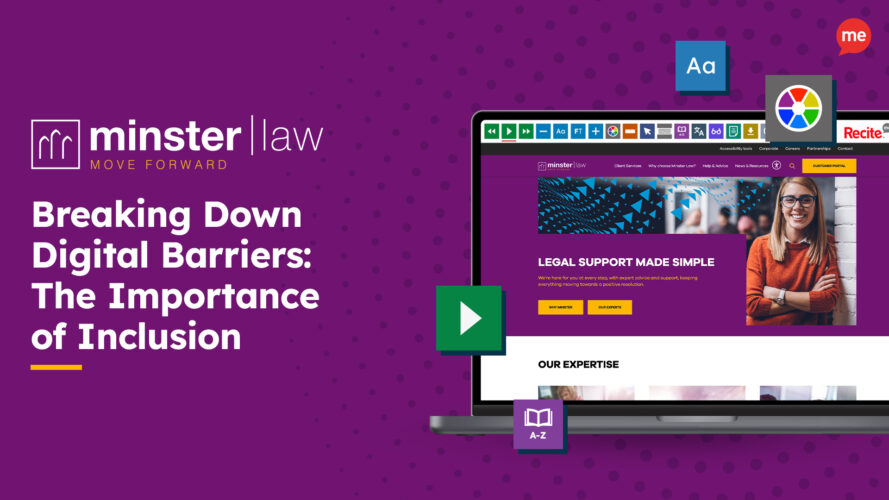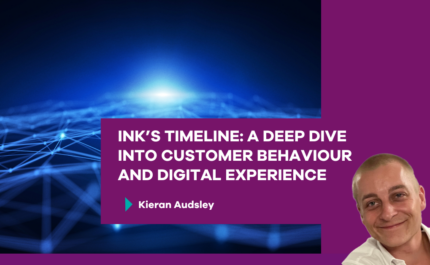
Recite Me/ Minster Law Customer Service Week
Breaking Down Digital Barriers: The Importance of Inclusion
Digital barriers refer to obstacles that prevent individuals, particularly those with disabilities, from effectively accessing or interacting with online content. These barriers can take many forms, hindering seamless navigation of websites and digital platforms, and making it difficult for users to understand or engage with content. For businesses and organisations, creating a barrier-free website is not just a legal or ethical obligation but also a strategic business decision.
By ensuring that your content is inclusive, you open the door to a broader audience and ensure that your products and resources are available to everyone. Here are some compelling reasons why accessibility matters for your business:
- People with disabilities control $8 trillion in annual spending (Medium).
- The spending power of disabled people and their families is rising by 14% per year (Purple Tuesday).
Beyond the financial benefits, creating an inclusive digital experience improves brand reputation, enhances customer satisfaction, and can significantly increase market share. Here’s a closer look at some specific advantages of embracing accessibility:
- Loyal Brand Ambassadors – When your website is accessible, more people will have positive experiences with your brand. This not only drives loyalty but also increases word-of-mouth recommendations, expanding your reach organically.
- Corporate Social Responsibility (CSR) & Community Support – Consumers are increasingly socially conscious, with 52% of shoppers considering a company’s values when making a purchase. Demonstrating a commitment to accessibility strengthens your CSR profile and resonates with this growing audience.
- Improved SEO – The Web Content Accessibility Guidelines (WCAG) align closely with SEO best practices. By following accessibility standards, businesses not only make their platforms more inclusive but also enhance their search engine rankings, reduce maintenance costs, and reach a wider audience.
Understanding the Scope of the Disability Market
An estimated 1.3 billion people, or 16% of the global population, live with some form of disability (World Health Organisation). Of this group, 70-80% have hidden disabilities, such as visual or hearing impairments, neurodivergent conditions like dyslexia, certain forms of autism, or other medical conditions.
Despite this significant population:
- 73% of disabled customers encounter accessibility barriers on more than a quarter of the websites they visit (We Are Purple).
- Disabled individuals are over 50% more likely to face digital access barriers than non-disabled people (Scope).
Moreover, 62% of adults with a disability own a desktop or laptop computer, and 72% own a smartphone (World Economic Forum), highlighting the need for accessible digital experiences across devices. By addressing digital barriers, you’re not only fostering inclusivity but also unlocking significant potential in an underserved market.
For businesses that want to thrive in a modern, socially-conscious economy, creating accessible digital platforms is no longer optional—it’s essential.
How usage of the Recite Me toolbar and training resources have improved our approach at Minster Law
At Minster Law, we began our journey following an internal accessibility audit of our customer-facing channels to see where we had gaps and opportunities to improve. We knew that we wanted to add flexibility for users on our digital channels so those with accessibility requirements could make any adjustments needed.
At the same time, our ED&I committee was working on improving accessibility in our recruitment processes as we joined the government’s disability confidence scheme.
We launched Recite Me’s accessibility toolbar in May, and since then, we’ve seen it used by 30% of users on our customer portal and over 10,000 pages viewed. We’ve also seen content translated into Polish, Persian, Russian, German, Arabic, Afrikaans, Armenian, Albanian, Panjabi/Punjabi, Lithuanian, Spanish (Spain) and Dutch.
The insight we receive from Recite Me has allowed us to see what features are most popular with users, which has helped shape our focus on areas of improvement.
Customer Experience Manager Annie Wescott said, “Over the next year, we’ll continue focusing on accessibility in communication as a key initiative for both customers and colleagues. Recite Me’s accessibility resources and training webinars have been fantastic in supporting us with best practices and considerations.”
As businesses look ahead to 2025, improving accessibility should be a top priority for creating more inclusive digital experiences. Companies should focus on integrating accessibility into every stage of digital development, from design to implementation, ensuring that their digital platforms are fully navigable for people with disabilities. Embracing assistive technology, training teams on accessibility practices and regularly auditing digital content is critical. By prioritising accessibility, businesses can meet legal and ethical requirements. To get started, check out Recite Me’s checklist for website accessibility.



